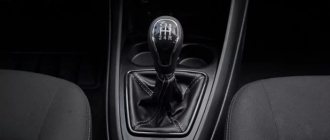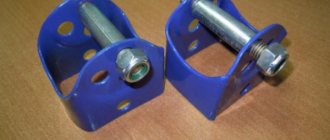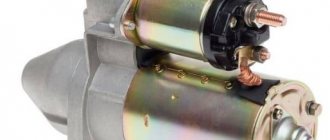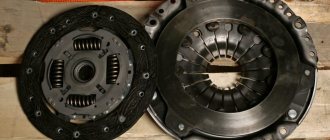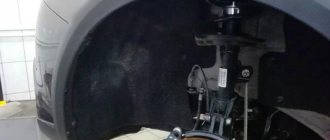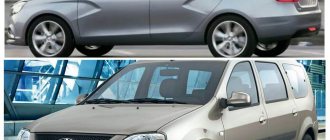The sedan has no obvious flaws, but minor childhood ailments can spoil the impression of buying a three-year-old Vesta.
The release of Lada Vesta became a real breakthrough for AvtoVAZ over the entire existence of the auto giant. Vesta itself became the first domestic car whose owners are not ashamed of it thanks to its characteristics, comfort, and attractive design that are similar to many foreign cars of the same class. Today, for a three-year-old Lada Vesta they are asking about half a million rubles, but is the used hit of the Russian market worth this money?
Chassis: squeaks, knocks
The creaking of rubber bands in the front suspension “does not affect the speed,” but is annoying. It can be treated by injecting lubricant or replacing it with a non-original one. Although owners of new cars claim that parts from the assembly line are now also quieter.
Most often they complain about knocking noises from stabilizer struts and, less often, from shock absorbers. In the first case, the original parts have become more reliable, so you can safely install original ones. And there are plenty of substitutes on sale, and they literally cost pennies. In short, there is no need to be afraid of malfunctions. It is perfectly audible when driving - a short test drive is enough to notice the extraneous sound. The shock absorbers themselves usually tap unobtrusively and with such a background they can regularly travel tens of thousands of kilometers. However, this drawback can also be used to your advantage when purchasing by bargaining for an additional discount.
Serious investments in suspension should not happen until at least 100,000 km. In terms of quality retention and service life, Vesta is inferior to the tenacious Renault on the B0 platform, but on our roads it shows very good results.
Serious investments in suspension should not happen until at least 100,000 km. In terms of quality retention and service life, Vesta is inferior to the tenacious Renault on the B0 platform, but on our roads it shows very good results.
Brake system: consumables for pennies
It all depends on the car’s mileage, the owner’s driving style and the amount of highway use. I had two sets of original pads on the front for 40,000 - 45,000 km with fairly active driving. The discs “fit” along with the second set. It is guaranteed that you will not have to climb thousands into the rear drum mechanisms until the mileage is 120. And, most likely, more.
Starting prices for brake system consumables are tempting: pads for only 200 rubles! Such details do not inspire confidence, so it is better to fork out for something more expensive and trustworthy.
Starting prices for brake system consumables are tempting: pads for only 200 rubles! Such details do not inspire confidence, so it is better to fork out for something more expensive and trustworthy.
If the owner of the Vesta you liked skimped on brake system components, this could affect the car’s behavior. During a test drive, pay attention to whether the brakes squeak, whether there are jerks when braking, or whether the mechanisms jam after the brake pedal is released. Everything noted can be used when discussing the price of a car.
conclusions
Generally speaking, the three-year-old Lada Vesta is a good option: there are no obvious mistakes, and minor defects may well have already been corrected by the previous owner under warranty or a recall company.
But it is still unfortunate that the main problems of Vesta lie in the quality of Russian parts, assembly and design flaws of the first machines. With them, Vesta will not let the new car owner relax, unless, of course, they were removed by the previous owner first.
However, we must pay tribute to AvtoVAZ: the auto giant’s main model is constantly being modernized, therefore, when buying a new Lada Vesta, you can count on it no longer having the listed “childhood ailments.” Thus, comparing the difference in the cost of a new Vesta and a three-year-old one, the conclusion suggests itself - it’s better to add 200-300 thousand rubles and get a new one. If we also remember the expenses for monthly maintenance of a used Vesta, as well as for its “finishing”, their size may well reach amounts equal to loan payments for a new Vesta.
Or an alternative option: wait another year or two, when prices for used Vestas drop to a fair 300-400 thousand rubles. Moreover, in a year or two an updated Vesta will appear.
Body: all chipped, but not rusting
Vesta's body resists corrosion well. The quality of steel and its protection is top notch! Even chips down to bare metal remain shiny with its natural color. But the quality of painting is not the best. The hood, front bumper and fenders quickly become covered with white chipped spots. But since they don’t “bloom,” I see no reason to make a problem out of it.
Rust on a used car is a sign of poor quality repairs. At least for now, Wests are no more than 4.5–5 years old.
The chrome on the car is unstable and takes on a shameful appearance after three or four winters.
The chrome on the car is unstable and takes on a shameful appearance after three or four winters.
The exhaust system mounts live and do not require attention. The burnout that occurred on our car in the corrugation area is rather an exception.
Our case of corrugation burnout is rare. For the most part, graduation on Vesta does not cause any trouble.
Our case of corrugation burnout is rare. For the most part, graduation on Vesta does not cause any trouble.
Buying Vesta: Lada is more honest than Hyundai!
Drom continues a series of studies on the purchase of popular cars. Last time we “bought” a Hyundai Solaris and were faced with the fact that dealers shamelessly profit from customers by selling cars exclusively with additional equipment at inflated prices. Moreover, as managers of dealership centers of various brands assure us, it is now impossible to buy a car without “extras” worth hundreds of thousands of rubles. It was all the more interesting for us to start “purchasing” the Lada Vesta, the second most popular model in Russia.
An important factor for determining the object of “purchase” is that of the total sales volume of the family, one half (with a slight margin) is sedans, and the other half is station wagons (at the end of 2022, the ratio is 54,029 to 53,257 units, respectively). This takes into account the regular and “cross” versions. Moreover, the share of cross-sedans is small, while the SW Cross station wagons are decent. That is, we will consider a sedan for purchase as the main option, but with a possible eye on a station wagon, at least a regular one, because it is already noticeably more expensive than a sedan.
Statistics will again help you decide on the required equipment: the second level of Comfort equipment is in greatest demand in the family as it is optimal for the model in terms of equipment saturation and price. But taking into account that there are additional versions of Comfort Winter and Comfort Winter Enjoy Pro, which can be regarded as factory optional packages, while other official “extras” are not provided.
If desired, you can even find a gas modification Vesta CNG in stock. It differs from the usual one by an additional refueling “connector” under the gas tank flap and a large gas cylinder in the trunk, which “eats” most of itIn terms of technology today, the choice is simple: a base 1.6 liter engine with 106 horsepower paired only with a manual gearbox or a Japanese tandem of a 1.6 liter engine with 113 horsepower and only with a continuously variable automatic transmission (variator). The 1.8 liter engine (122 hp) is available only in cross-versions. The lion's share of sales (about 85%) still falls on the VAZ power unit, so we will take it as an item of preference.
The Comfort package includes front airbags, ESP, rear parking sensors, air conditioning, front armrest box, driver's seat with height adjustment, heated seats, cruise control, multifunction steering wheel, audio with USB, SD, AUX, Bluetooth and four speakers, electric drive and heated mirrors, rear electric windows, an additional socket, mirror housings and handles in body color.
At the time of collecting information, the minimum price according to the price list for a regular sedan with a base engine in this configuration was 804,900 rubles. With the Winter package (front fog lights, heated windshield, heated leather steering wheel) the price is 828,900 rubles, and with the Winter Enjoy Pro package (additional multimedia with an 8-inch display, rear view camera) - 876,900 rubles. But the regular Lada Vesta SW station wagon with the same equipment is at least 59,000 rubles more expensive: 863,900, 887,900 and 935,900 rubles, respectively.
Plus, 12,000 rubles for the metallic color. It is advisable for us to stick to “pure” Comfort, without overpaying for options, but whatever happens.
Moscow: buy! Don't want!
Ladas are not particularly popular in Moscow. Nevertheless, there are two dozen official dealers in the capital region. Is there a place to choose?
On the one hand, yes, there is. On the other hand, more than half of the Lada dealer pie is divided between two holdings: Tekhinkom and Autohermes. Theoretically, this gives a better chance of finding the car you need (in large dealer networks and large deliveries). But in practice, it often happens that the car that suits you is not at the dealer’s site, but at the central warehouse. Or from another dealer. Therefore, it is not always possible to come with money and leave by car within an hour. However, let’s not consider this a disadvantage: for some brands, the wait for the ordered car does not last until the evening or even until the next day - for several months!
Lada, thank God, doesn’t have to wait. Although on the Tekhinkom website the section “Cars in stock” essentially does not work - you can either go to the “Configurator” or... order a test drive!
But what’s worse is that customer feedback doesn’t work either. After asking a question in the pop-up chat window, I still didn’t get an answer even after five hours! The call order form also didn’t work—they clearly weren’t going to call the potential client back from Tekhinkom...
Well, if the mountain doesn't come to Mohammed, Mohammed goes to the mountain. I find the nearest Techinkoma DC and go there. By the way, I don’t consider the location of dealership centers on (or rather, outside of) the Moscow Ring Road to be convenient: there is little public transport in these areas, and it’s a long walk from the nearest residential areas.
In an almost empty (that is, almost no visitors) showroom, we had to wait for a free (!) manager for some time. By the way, the conversation with him was interrupted several times by phone calls. And while the manager was solving parallel issues and searching the computer for the cars we needed in stock, I found what I was looking for myself - right in the showroom.
Thanks to carefully installed extras, a brown sedan in the Comfort package was priced at 905,000 rubles, which is 88,100 more than the recommended price - anti-noise underbody protection, Johnson tinting, radiator protective mesh, rear mudguards, Scher-Khan Mobicar 1 alarm system and a set of floor mats. An approximately twofold overpayment for such a set of “extras” (relative to their market prices) in comparison with the appetites of Hyundai dealers still looks quite humane. Although the alarm system is already outdated - the dealer, apparently, is “cleaning out” its warehouse stocks...
What if there are no extras? It’s possible without them (here Hyundai dealers twitched nervously
